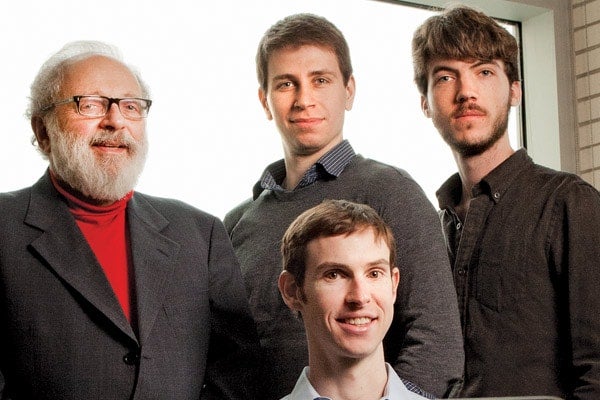
e-Reading with Grandma
Published: November 28, 2011
Facebook, Twitter, e-readers, video games, and the seemingly endless “next generations” of smartphones.
Aside from the positive impact of social media on the retail sector and job creation, is all this e-stuff really necessary? Has the social media revolution really made life better?
That debate is still ongoing.
But spend some time with computer science professor Ron Baecker and the talented young minds who work with him in U of T’s TAGlab and it is easy to see that the gizmos that gazillions of people around the world use to tweet or share their vacation photos can be adapted to help people who are having trouble as they age.
TAGlab stands for the Technologies for Aging Gracefully Laboratory. It’s the latest in a long and impressive line of research initiatives launched over the past 40 years by Baecker — named by ACM SIGGRAPH (an international computer graphics society) as one of the 60 pioneers of computer graphics — that adapt information technology to help people learn more effectively or assist those who have a cognitive or communications challenge.
“Our mantra is ‘Technologies for the journey through life’,” says Baecker. “We look at the needs people face as they age. Then we look around in our grab bag of nifty technologies and we play with them, matching people’s needs with adaptations of the technology. And then we find a bright student to explore it and build a prototype and we begin testing it.”
TAGlab — which also includes almost 20 faculty collaborators worldwide from a huge range of disciplines — has already come up with a hit — MyVoice, a mobile app and server system that operates on iPhone and Android devices and gives users with aphasia, autism and other conditions that hinder speech a voice, by tapping words and pictures on a screen. Developed under Baecker’s direction by Alexander Levy, Aakash Sahney and Kevin Tonon, the device won the team a U of T Inventors of the Year award and is now available in the marketplace.
And other innovations are on the horizon.
Among them is the Accessible Large-Print Listening and Talking (ALLT) e-bo ok (pictured below). There are a number of technologies available to assist people with a visual impairment or who are legally blind to access the contents of digital books. Baecker and graduate student Xavier Snelgrove (at the time an undergraduate Engineering Science student) developed the technology, based on Snelgrove’s experience in reading with his grandmother, by then almost blind. “Xavier came up with the notion that if a machine could record his voice, his grandmother could listen to it over and over again. Hearing his familiar voice makes the experience more pleasant than hearing a computerized voice. That idea has led to our development of ALLT, and the work is now being carried on by Ph.D. student Velian Pandeliev and research assistant Liam Kaufman.”
ok (pictured below). There are a number of technologies available to assist people with a visual impairment or who are legally blind to access the contents of digital books. Baecker and graduate student Xavier Snelgrove (at the time an undergraduate Engineering Science student) developed the technology, based on Snelgrove’s experience in reading with his grandmother, by then almost blind. “Xavier came up with the notion that if a machine could record his voice, his grandmother could listen to it over and over again. Hearing his familiar voice makes the experience more pleasant than hearing a computerized voice. That idea has led to our development of ALLT, and the work is now being carried on by Ph.D. student Velian Pandeliev and research assistant Liam Kaufman.”
Baecker says ALLT is unique in comparison to other existing e-book reader technologies because it also has a listening and talking capability. ALLT records the voice of a family member when she or he reads aloud for a person with vision loss; the recorded content can then be replayed later. The team is now beginning systematic testing of ALLT with individuals who have difficulties reading because of vision loss, or because they cannot hold books or turn pages.
Other projects have focused on the use of digital multimedia to stimulate recall, reminiscence, and social engagement in individuals with Alzheimer’s disease or Mild Cognitive Impairment. For example, together with Professor Elsa Marziali of Baycrest and the Factor-Inwentash Faculty of Social Work, the team developed an effective method for creating and using multimedia biographies.
“We approach our work here on three themes — giving people autonomy, helping them maintain their identity and helping them stay connected with others in their own personal communities of family and friends. And we pull all that together under one question that drives us: What can you do with technology to empower people to continue to do things that were important in their lives, or even to do things that they couldn’t do before?”


